The English conceived fly-fishing as a gentlemanly pursuit to be undertaken dressed in a tweed jacket while possibly smoking a pipe, a sophisticated sport, with delicate flies finessed to rising trout. However, as Joshua Hutchins discovers flying into the wilds of Mongolia in a helicopter gunship, someone forgot to tell the Mongolians. Here there be no tweed jackets, but there are flies the size of rats and the biggest trout you’ll ever see!
Known for its rugged steppes and nomadic people, Mongolia is also home to some of the world’s largest trout. Wedged between Russia and China, Mongolia has endured a difficult and colourful history. Its isolation and political climate meant tourists only first began to visit in numbers in the 1990s. Today the country has emerged as one of the most tempting travel destinations in the world. Once known primarily for the exploits of the mighty emperor Genghis Khan, who conquered most of the known world in the 12th and 13th centuries, Mongolia is now fast gaining a big reputation for its extraordinary fishing.
Taimen, found predominately in Russia and Mongolia, are the largest trout species (Salmonid family) in the world. After fishing for trout my whole life, catching a taimen on a fly was an experience I couldn’t miss. Hooking up with Sweetwater Travel on their annual taimen adventure, Robbie Lee and I left Sydney in late September for the Mongolian capital, Ulaanbaatar. The country was a complete mystery to me and apart from the hope of seeing giant taimen exploding onto surface flies, we had no idea what to expect.
ULAANBAATAR
Ulaanbaatar is the centre of a now-vibrant economy, boosted by intense mining expansion. In contrast to the vast wilderness and rugged mountains surrounding the city, it’s a hive of activity. Home to nearly half the country’s population, it has a unique mix of businessmen, rural nomads and hipsters (yes, the Mongolian version does exist).
Waking in our hotel, bleary-eyed from the late arrival, I suggested we head into town. It was important to check out the local culture. A few quick directions and we were on our way to the famous black market. Sifting through the usual trinkets, we soon found what we needed to blend in ‑ traditional Mongolian fox hats, legs and tails still attached. Possibly ripped off, and most likely victims of a practical joke, Robbie and I proudly set off with our first Mongolian purchase. Maybe the hats would give us some local mojo for catching taimen.
THE ADVENTURE BEGINS
The rest of our fishing group, although separated by countries and personalities, all had one thing in common – we’d all travelled halfway around the world in pursuit of a taimen on fly.
We left our hotel and at our next checkpoint were greeted by four men in military attire, a former Soviet-era MI-8 helicopter standing in the background. The adventure had begun.
After our group and gear was loaded, the chopper took off, heading north-east towards the Russian border. With the deafening drone of the rotors, I kept my eyes glued to the small portholes. Nomads herding stock, wide, clear rivers, and forests embracing the colourful change of season ‑ the scenery couldn’t be more majestic. Finally, our destination appeared: the Eg-Uur river system.
Landing by the river, we settled into our Mongolian ger camp. Large round tents, covered by skins or felt, traditional gers are used as dwellings by nomads on the Mongolian steppes. The experience was as authentically Mongolian as it gets. Each morning and night, we enjoyed the comfort and warmth of the ger with a pot stove slowly heating up our room.
SQUIRRELS AND TAMIEN
When arriving at a new fishing destination, I get a bit excited. My mind goes into overdrive thinking of all the possibilities and adventures ahead. Our guides briefed us on the fishing, flies and species available. They mentioned taimen, lenok, northern pike, grayling and perch – but I really only heard the first one – I was after a taimen.
Bayra, one of our local guides, looked through his fly box for options. This was not a normal fly box. It included flies that imitated large rodents, squirrels, and 20cm fish. It was clear the taimen weren’t looking for an entrée!
“Would you like to fish a surface fly or sub-surface streamer?” Bayra asked. His question was like asking a fat kid would he like a carrot or chocolate cake. “Surface!” we replied in unison.
With 140km of river system to explore by jet boat, it was time to hit the water. With big rods, big flies and hopes for a big fish, Robbie and I made our casts from the boat towards likely runs and edges. The basic plan was to locate the best-looking water with the speedboats, and either pull into the banks to fish the runs, or slowly drift the larger water from the centre of the river, dragging a heavy anchor to slow the drift and allow time to cover every piece of likely water.
Then, all of a sudden, Boom! Robbie had cast his fly and no more than five seconds into the retrieve a taimen had launched clear of the water to hit it. Being our first strike, we were eager to see the fish in the flesh. Full of fight, the 80cm beast finally made its way to the bank. A beautiful golden-brown specimen scattered sparsely with black spots – it was a stunning fish.
Over the next six days we covered several different areas of the river with an ever-changing landscape. The lower sections of the river were often wider, with slow-flowing pools, oozing with large taimen vibes.
My biggest encounter came on the fourth day. After being told all week that the bigger fish would bite when the first cold set in, we finally woke to our first frost. Expectation was high.
The upper river section of our camp was the most spectacular. As we motored upstream the mountains seemed to grow in height and intensity, like shadows in the afternoon. The rugged steppes were a stark contrast to the open blue sky. When the valley finally started to close in, Matt, our guide for the day, stopped the boat and said it was time to start fishing.
What I thought was good looking ‘trout-water’ often didn’t prove the best taimen holding spots. We found the bigger fish towards the tail-out sections of larger pools and in areas without any structure. However, towards the top section of the river, as the water guzzled and carved its way through larger boulders, gaining speed through each crevasse, the fish responded differently.
Enjoying a quick lunch anchored in the middle of a large pool, it was time to make our way downstream. This looked to be some of the most ‘fishy’ water we had covered with large boulders submerged in the depth of the pool. My squirrel-skater fly slowly pulsed along the surface until it suddenly stopped. So did my heart as I watched a huge shadow rising from the depth to boil on the fly without actually eating it. I continued to retrieve with varied pauses, hoping to entice a take. Twice more this fish, well over 1.3m, boiled and circled the fly, clear as day. Surprisingly ignorant of my yelling encouragement to “eat it, eat it!” the beast eventually disappeared into the depths. Even several fly changes wouldn’t bring a rematch.
Filled with equal parts adrenaline and disappointment, I continued to fish out the rest of that pool. Barely five more casts and another fish, this one a metre in length, rose to my fly. This time, the fish hit it and, without consuming, tailed the squirrel imitation for another 10 metres, nosing it along the surface. Finally deciding it was time to eat, with a huge surface explosion, he consumed his meal. Shaking with excitement, I managed to land this mighty fish and witness the beauty of another taimen. I was so thrilled to have landed this fish, but will be forever haunted by my encounter with the even bigger one that got away!
CLEARWATER PIKE
Besides the giant taimen, there are several other willing species in the same river system. Lenok and grayling, often preyed upon by the taimen, are great fun on lighter rods. No more than five minutes after dropping my bags at the ger camp, I had landed several of both fish. Each morning and afternoon, they would happily rise to small flies right in front of the camp. Despite their small mouths, larger lenok often attacked our squirrel flies, embracing any opportunity for food with a cold winter ahead.
A surprising highlight was the northern pike fishing. Several guides casually mentioned there were pike in the river and having never caught one before, we decided to give it a try.
The pike live in the clear backwaters of the main river and offer exciting sight fishing to large fish. After some precarious log-hopping, we made our way into a section of water home to some friendly pike. As we worked surface flies through the likely weed gaps, huge bow waves would encroach on the area, revealing their position. “Here it comes!” I called to Robbie as a fish travelled 10 metres to claim his fly. After a big hit from the surface and a strong fight, Robbie was happy to claim a 1.15m specimen in his first session.
We enjoyed the pike so much we returned for more the next day. Sadly, this time we forgot the wire trace, and with teeth that made quick work of 60lb monofilament line, we didn’t stand a chance with the larger fish.
Mongolia not only delivered a unique fishing experience, but so much more. Endless wild countryside, friendly locals and undisturbed night skies with more stars than I have ever seen, left me marvelling at this beautiful country. Like many fishing tales I have the one that got away – but hopefully not for long.
TOP FLIES
Our preference was to fish surface patterns for taimen. Large flies imitating rodents and ground squirrels were the most popular. My most-used fly was the ‘Squirrel Skater’.
Large sub-surface streamers also imitated the taimen’s subsurface diet of fish. A favourite for me was the ‘Game Changer’, tied with several segments giving the prefect articulation of a wounded grayling. Lead-eyed bunny and deceiver patterns were also handy. All flies should be tied on 1/0 to 4/0-sized hooks.
GEAR
In most of the protected fisheries in Mongolia, the only fishing style allowed by foreigners is fly fishing. A single de-barbed fly assists a quick and safe release of each fish.
Taimen flies are large, not to mention the size of the fish, so 8-10 weight fly rods with shooting head fly line tapers are recommended. Floating lines are used for the dry fly fishing. A fast-sinking fly line is also handy for the deeper holes.
We used the same rig to chase northern pike in the gin-clear backwaters of the river, while 4-5 weight fly fishing outfits with a floating line are a fun inclusion to target lenok and grayling.



























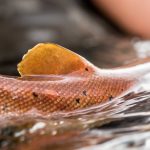


















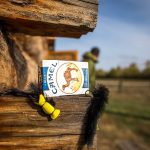

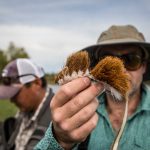










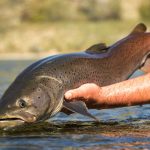

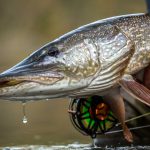
Recent Comments